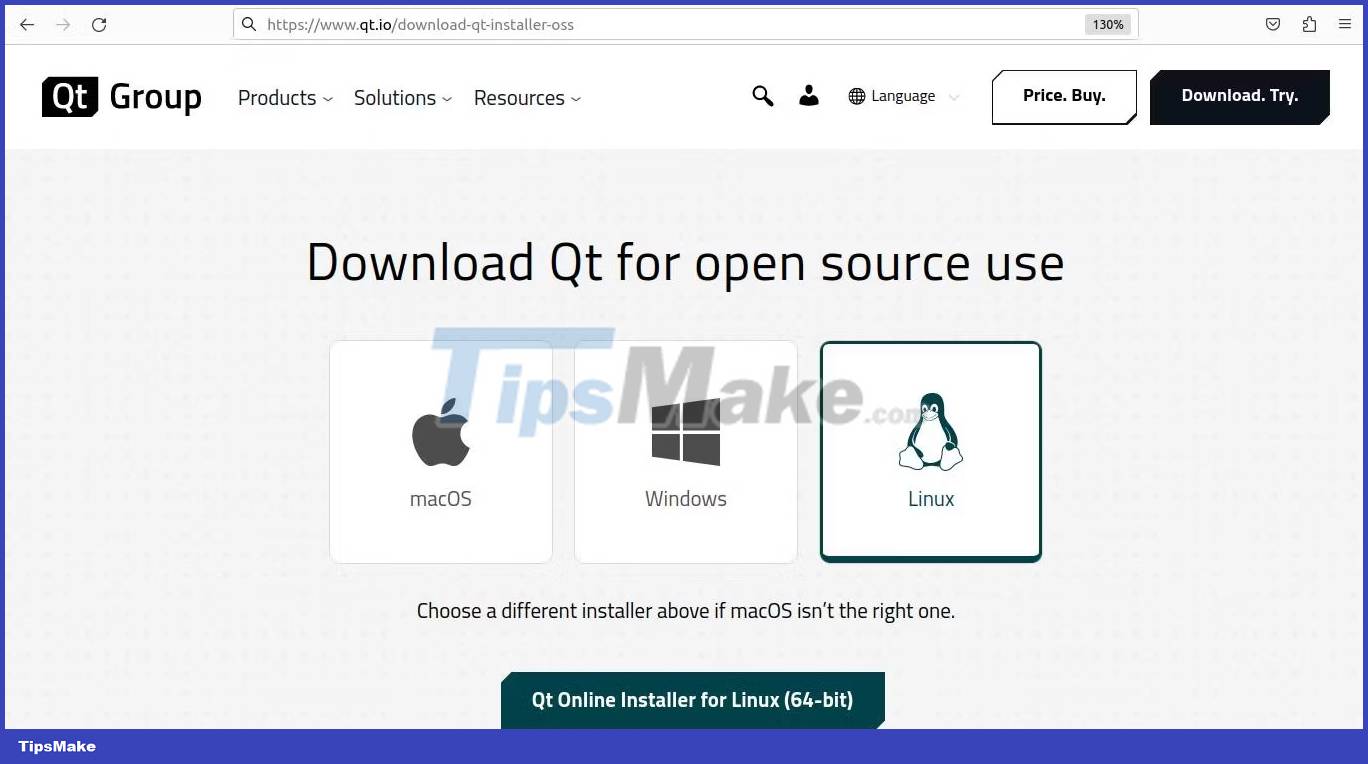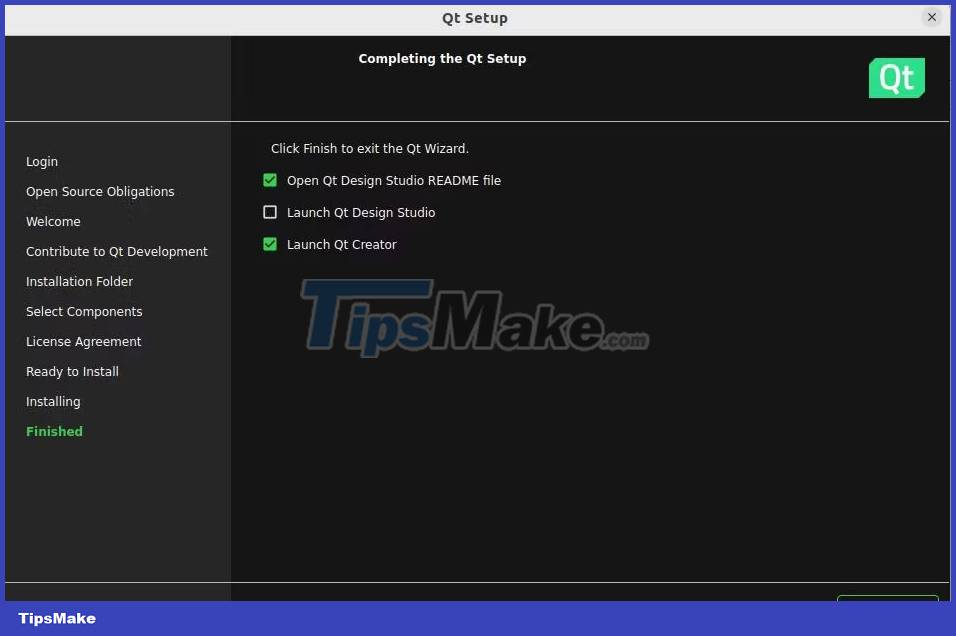How to install Qt for GUI application development on Linux
Used primarily as a way for rapid GUI development, Qt also provides tools for networking, file handling, and database integration. This is how you can install QT on Linux.
How to install Qt on Linux
Qt is available as an offline and online installer. For ease of use, the developers recommend using the online version.

Open a browser and go to the Qt download page.
Download Qt
Qt is available for Windows, macOS, and Linux, and the site will automatically detect that you're running Linux. If not, click the penguin icon, then click Qt Online Installer for Linux .
The download is about 50MB and will be named qt-unified-linux-xxx.xxrun , where xxx-xxx is your processor architecture and Qt version number. The download will take up to a few minutes.
In terminal, navigate to where you downloaded the package. In most cases, this will be the Downloads folder .

Make the file executable with:
sudo chmod +x qt-unified-linux-*.runEnter your password when prompted, then launch the installer with:
./qt-unified-linux-*runYou need a Qt account to install Qt. If you already have one, enter your email address and password.
If you don't have a Qt account yet, click Sign up , create an account with your email address and password, and check the box to confirm that you've read the terms of service.
Click Next and if you're just creating an account for the first time, check your email, click the confirmation link, and continue setting up your account.
Now you can go back to the installer and click Next again.

On the next screen you will have to check another box confirming that you have read and agree to the terms and conditions of using the open source Qt, and also enter your company name or check the box confirming that you is an individual who does not use Qt on behalf of any company.
If you are sure you can comply with the obligations, click Next again . Over the next few clicks you will have to confirm the welcome screen, decide whether to contribute pseudonymous usage statistics, and choose the directory where Qt will be installed.
Then you can choose the Qt components you want. The defaults should be appropriate for most use cases.

The next screen contains 4 separate license agreements. Read these documents carefully, check the box to confirm you have done this and click Next , then select Install to begin the installation.
The total download is about 2GB and may take some time.

Once the download is complete, you will be asked if you want to view the README file, launch Qt Design Studio, or launch Qt Creator. Uncheck these if you want to start working immediately, then click Finish .
You should read it
- Run Windows applications on Linux, macOS and other platforms
- How to run Windows applications on Linux with Vineyard
- How to Learn Linux
- Why don't developers make more apps for Linux?
- How to install and use Kali Linux on VmWare virtual machine
- How to install Solus Linux
- How to install Kali Linux on macOS
- 5 reasons to install Linux on old computers
May be interested
- How to install and use Kali Linux on VmWare virtual machine
 until now, a famous linux distro, kali linux, has always been sought by security experts or hackers. why? simply because kali linux has a built-in range of tools for penetration, hacking, analysis, etc. all are categorized very clearly.
until now, a famous linux distro, kali linux, has always been sought by security experts or hackers. why? simply because kali linux has a built-in range of tools for penetration, hacking, analysis, etc. all are categorized very clearly. - History of Linux operating system, a strange development path
 the development process of linux is a strange journey. 'many people don't even know they're using it. linux is everywhere.
the development process of linux is a strange journey. 'many people don't even know they're using it. linux is everywhere. - How to install Solus Linux
 recently, the linux community has given winged compliments to solus linux. this is understandable because this is a beautiful operating system with lots of great features. in a world where most popular linux distributions are 'derivative ubuntu', solus linux really stands out.
recently, the linux community has given winged compliments to solus linux. this is understandable because this is a beautiful operating system with lots of great features. in a world where most popular linux distributions are 'derivative ubuntu', solus linux really stands out. - How to run Windows applications on Linux with Vineyard
 if you recently switched to linux, but still remember windows applications, read this article to learn how to run windows applications and software on this operating system.
if you recently switched to linux, but still remember windows applications, read this article to learn how to run windows applications and software on this operating system. - Ways to install Microsoft Excel on Linux
 converting from windows to linux is very simple, but there are a number of issues that are incompatible software. what if you want to use microsoft excel on linux? look at this article and find the answer!
converting from windows to linux is very simple, but there are a number of issues that are incompatible software. what if you want to use microsoft excel on linux? look at this article and find the answer! - How to use Zsh (or other Shells) on Windows 10?
 bash shell is integrated into windows 10 anniversary update version is just a compatible class to run linux software on windows operating system. you can use the bash shell to run zsh or any shell you want.
bash shell is integrated into windows 10 anniversary update version is just a compatible class to run linux software on windows operating system. you can use the bash shell to run zsh or any shell you want. - Instructions for installing Kali Linux on Windows 10 are easier than ever
 you can download and install kali linux directly from the microsoft app store on windows 10 as easily as installing any other application. this is a guide to installing kali linux on windows 10, without usb boot, virtualization software at all.
you can download and install kali linux directly from the microsoft app store on windows 10 as easily as installing any other application. this is a guide to installing kali linux on windows 10, without usb boot, virtualization software at all. - How to Install Oracle Java JRE on Ubuntu Linux
 this wikihow teaches you how to install the java runtime environment (jre) on a computer running ubuntu linux. while the most common way to install the jre is by installing the java development kit (jdk)—which installs the jre by d...
this wikihow teaches you how to install the java runtime environment (jre) on a computer running ubuntu linux. while the most common way to install the jre is by installing the java development kit (jdk)—which installs the jre by d... - Instructions for installing Windows software on Linux with PlayOnLinux
 playonlinux provides a point and click interface (point and click) to automatically install and edit software on linux. it is like a package manager but for windows games and other applications on linux.
playonlinux provides a point and click interface (point and click) to automatically install and edit software on linux. it is like a package manager but for windows games and other applications on linux. - 5 reasons to use Flatpak to install software on Linux
 you're probably used to the frustration when software fails to install. unfortunately, this is something almost every linux user encounters once or twice - and that's where application distributions like flatpak come in handy.
you're probably used to the frustration when software fails to install. unfortunately, this is something almost every linux user encounters once or twice - and that's where application distributions like flatpak come in handy.










 5 free websites and online games to learn about the Linux command line
5 free websites and online games to learn about the Linux command line 12 things Linux is easier to do in the command line than graphical software
12 things Linux is easier to do in the command line than graphical software How to install Elasticsearch on Ubuntu
How to install Elasticsearch on Ubuntu How to disable auto-suspend in Linux
How to disable auto-suspend in Linux 6 Best New Features in Linux Mint 21.2 'Victoria'
6 Best New Features in Linux Mint 21.2 'Victoria' How to fix NetworkManage not running on Linux
How to fix NetworkManage not running on Linux